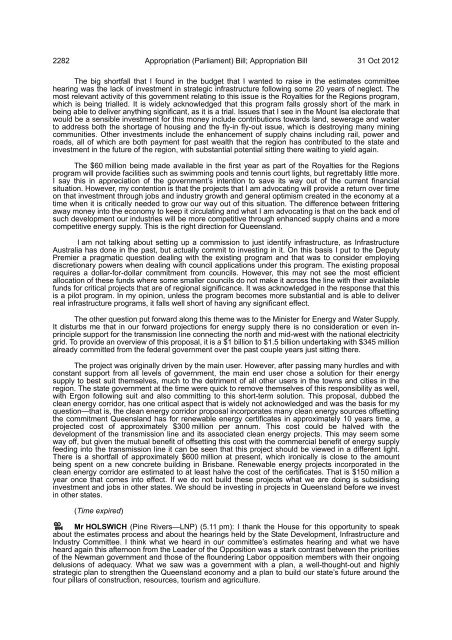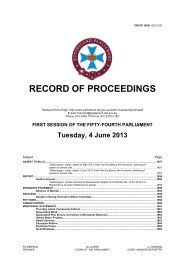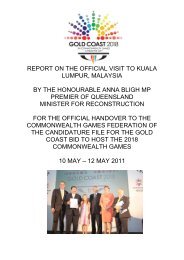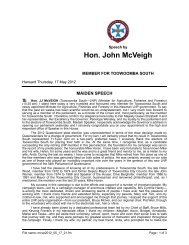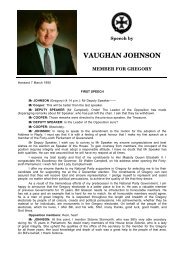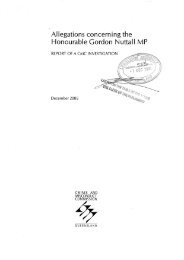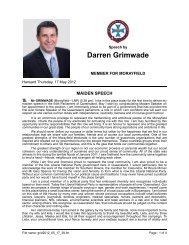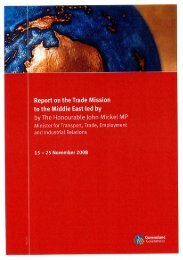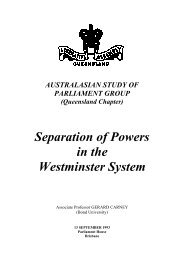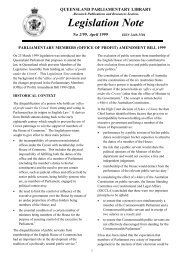RECORD OF PROCEEDINGS - Queensland Parliament ...
RECORD OF PROCEEDINGS - Queensland Parliament ...
RECORD OF PROCEEDINGS - Queensland Parliament ...
Create successful ePaper yourself
Turn your PDF publications into a flip-book with our unique Google optimized e-Paper software.
2282 Appropriation (<strong>Parliament</strong>) Bill; Appropriation Bill 31 Oct 2012<br />
The big shortfall that I found in the budget that I wanted to raise in the estimates committee<br />
hearing was the lack of investment in strategic infrastructure following some 20 years of neglect. The<br />
most relevant activity of this government relating to this issue is the Royalties for the Regions program,<br />
which is being trialled. It is widely acknowledged that this program falls grossly short of the mark in<br />
being able to deliver anything significant, as it is a trial. Issues that I see in the Mount Isa electorate that<br />
would be a sensible investment for this money include contributions towards land, sewerage and water<br />
to address both the shortage of housing and the fly-in fly-out issue, which is destroying many mining<br />
communities. Other investments include the enhancement of supply chains including rail, power and<br />
roads, all of which are both payment for past wealth that the region has contributed to the state and<br />
investment in the future of the region, with substantial potential sitting there waiting to yield again.<br />
The $60 million being made available in the first year as part of the Royalties for the Regions<br />
program will provide facilities such as swimming pools and tennis court lights, but regrettably little more.<br />
I say this in appreciation of the government’s intention to save its way out of the current financial<br />
situation. However, my contention is that the projects that I am advocating will provide a return over time<br />
on that investment through jobs and industry growth and general optimism created in the economy at a<br />
time when it is critically needed to grow our way out of this situation. The difference between frittering<br />
away money into the economy to keep it circulating and what I am advocating is that on the back end of<br />
such development our industries will be more competitive through enhanced supply chains and a more<br />
competitive energy supply. This is the right direction for <strong>Queensland</strong>.<br />
I am not talking about setting up a commission to just identify infrastructure, as Infrastructure<br />
Australia has done in the past, but actually commit to investing in it. On this basis I put to the Deputy<br />
Premier a pragmatic question dealing with the existing program and that was to consider employing<br />
discretionary powers when dealing with council applications under this program. The existing proposal<br />
requires a dollar-for-dollar commitment from councils. However, this may not see the most efficient<br />
allocation of these funds where some smaller councils do not make it across the line with their available<br />
funds for critical projects that are of regional significance. It was acknowledged in the response that this<br />
is a pilot program. In my opinion, unless the program becomes more substantial and is able to deliver<br />
real infrastructure programs, it falls well short of having any significant effect.<br />
The other question put forward along this theme was to the Minister for Energy and Water Supply.<br />
It disturbs me that in our forward projections for energy supply there is no consideration or even inprinciple<br />
support for the transmission line connecting the north and mid-west with the national electricity<br />
grid. To provide an overview of this proposal, it is a $1 billion to $1.5 billion undertaking with $345 million<br />
already committed from the federal government over the past couple years just sitting there.<br />
The project was originally driven by the main user. However, after passing many hurdles and with<br />
constant support from all levels of government, the main end user chose a solution for their energy<br />
supply to best suit themselves, much to the detriment of all other users in the towns and cities in the<br />
region. The state government at the time were quick to remove themselves of this responsibility as well,<br />
with Ergon following suit and also committing to this short-term solution. This proposal, dubbed the<br />
clean energy corridor, has one critical aspect that is widely not acknowledged and was the basis for my<br />
question—that is, the clean energy corridor proposal incorporates many clean energy sources offsetting<br />
the commitment <strong>Queensland</strong> has for renewable energy certificates in approximately 10 years time, a<br />
projected cost of approximately $300 million per annum. This cost could be halved with the<br />
development of the transmission line and its associated clean energy projects. This may seem some<br />
way off, but given the mutual benefit of offsetting this cost with the commercial benefit of energy supply<br />
feeding into the transmission line it can be seen that this project should be viewed in a different light.<br />
There is a shortfall of approximately $600 million at present, which ironically is close to the amount<br />
being spent on a new concrete building in Brisbane. Renewable energy projects incorporated in the<br />
clean energy corridor are estimated to at least halve the cost of the certificates. That is $150 million a<br />
year once that comes into effect. If we do not build these projects what we are doing is subsidising<br />
investment and jobs in other states. We should be investing in projects in <strong>Queensland</strong> before we invest<br />
in other states.<br />
(Time expired)<br />
Mr HOLSWICH (Pine Rivers—LNP) (5.11 pm): I thank the House for this opportunity to speak<br />
about the estimates process and about the hearings held by the State Development, Infrastructure and<br />
Industry Committee. I think what we heard in our committee’s estimates hearing and what we have<br />
heard again this afternoon from the Leader of the Opposition was a stark contrast between the priorities<br />
of the Newman government and those of the floundering Labor opposition members with their ongoing<br />
delusions of adequacy. What we saw was a government with a plan, a well-thought-out and highly<br />
strategic plan to strengthen the <strong>Queensland</strong> economy and a plan to build our state’s future around the<br />
four pillars of construction, resources, tourism and agriculture.


